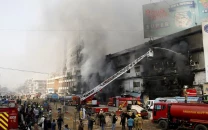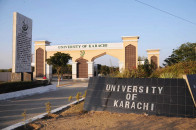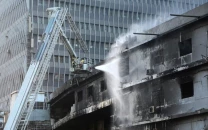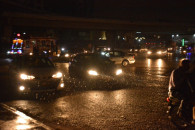Displaced by the flood, deserted by the government
Thousands forced to evacuate their homes find they must live under the open sky until the water recedes

Thousands of people have been forced to evacuate their homes and shift to higher ground. The residents complain of the apathetic attitude of government officials. PHOTO: EXPRESS
Kheera Mangwani Maachi, whose wrinkled face and dark complexion, give away her age to be in the late 50s, has seen at least eight floods in her lifetime. Each was accompanied by the ordeal of temporary homelessness.
Seated on a wooden charpoy, perched on a rocky slope near what has become a temporary riverbank at the heels of Makhdoom Bilawal Sahad's shrine in Jamshoro district, she narrates the ups and downs of the riverine life. "We moved out after [flood] water entered our homes near Unarpur [a rural town in Manjhand taluka]. The crops have been completely destroyed. Even all of our cattle haven't been evacuated yet." Her account, dominated by the travails of displacement and losses, reflects the story of almost all the flood-affected people.
Read: ‘2,300 houses damaged in DG Khan floods’
The flood - which has peaked at 725,000 cusecs at Guddu Barrage - currently passing through the length and breadth of the Indus river in Sindh does not threaten the settled areas, unlike its 2010 predecessor. Or so the government says. Yet all is not hunky-dory.
The provincial government estimates over 650,000 people of the katcha areas have been shifted to safer places, with the displacement expected to last between one to two months. The unofficial figures put the flood-affected residents of the riverine areas at around one million. But the relief has not been pouring in quick enough. "It would have been the third night that we would have to spend on the charpoys under the open sky," said a relieved Maachi, on receiving a tent from an NGO, the Pakistan Relief Foundation.

Most of the thousands of people who left Unarpur along with her for safety, have not been as lucky. The PRF's stock for distribution was enough for a few hundred only. But the people displaced from Unarpur, Budhapur and Manzoorabad, the rural towns along the Indus, appeared to be in the thousands. Dozens of the men and women among them, who spoke to The Express Tribune, complained of not receiving any government help.
"No one has come here, not even the Mukhtiarkar," said Darya Khan Khoso, a vegetable vendor from Unarpur.
The graveyard and land stretching several acres over the hilltop, adjacent to the shrine in Sahadabad, which is one of the closest hilly rural towns from Unarpur, provide the most suitable place for the encampment. Dozens of thatched roofs, pedestalled on tree trunks, and as many charpoys are seen scattered around.
"We spent two days at the Mukhtiarkar's office in Manjhand, requesting the officials to give us tents but they have kept us waiting," grudges Raju Thakur, who is one of hundreds of Hindu peasants displaced from their village on the riverbed on the outskirts of Manzoorabad.
According to the Provincial Disaster Management Authority chief, Syed Salman Shah, around 147,000 people were living in tents by Monday. "We have provided 24,000 to 25,000 tents to the district administrations but I will have to check how many of them have completed the distribution," Shah told The Express Tribune.
Read: Bilawal asks Sindh government to accelerate relief activities in flood-hit areas
He added that on August 8, Jamshoro's DC informed had him that 1,270 tents had been given to the affected people. Shah added that the PDMA has already supplied 4,000 tents to the district administration of Jamshoro and 1,000 more will be delivered by August 11.
Published in The Express Tribune, August 11th, 2015.



















COMMENTS
Comments are moderated and generally will be posted if they are on-topic and not abusive.
For more information, please see our Comments FAQ